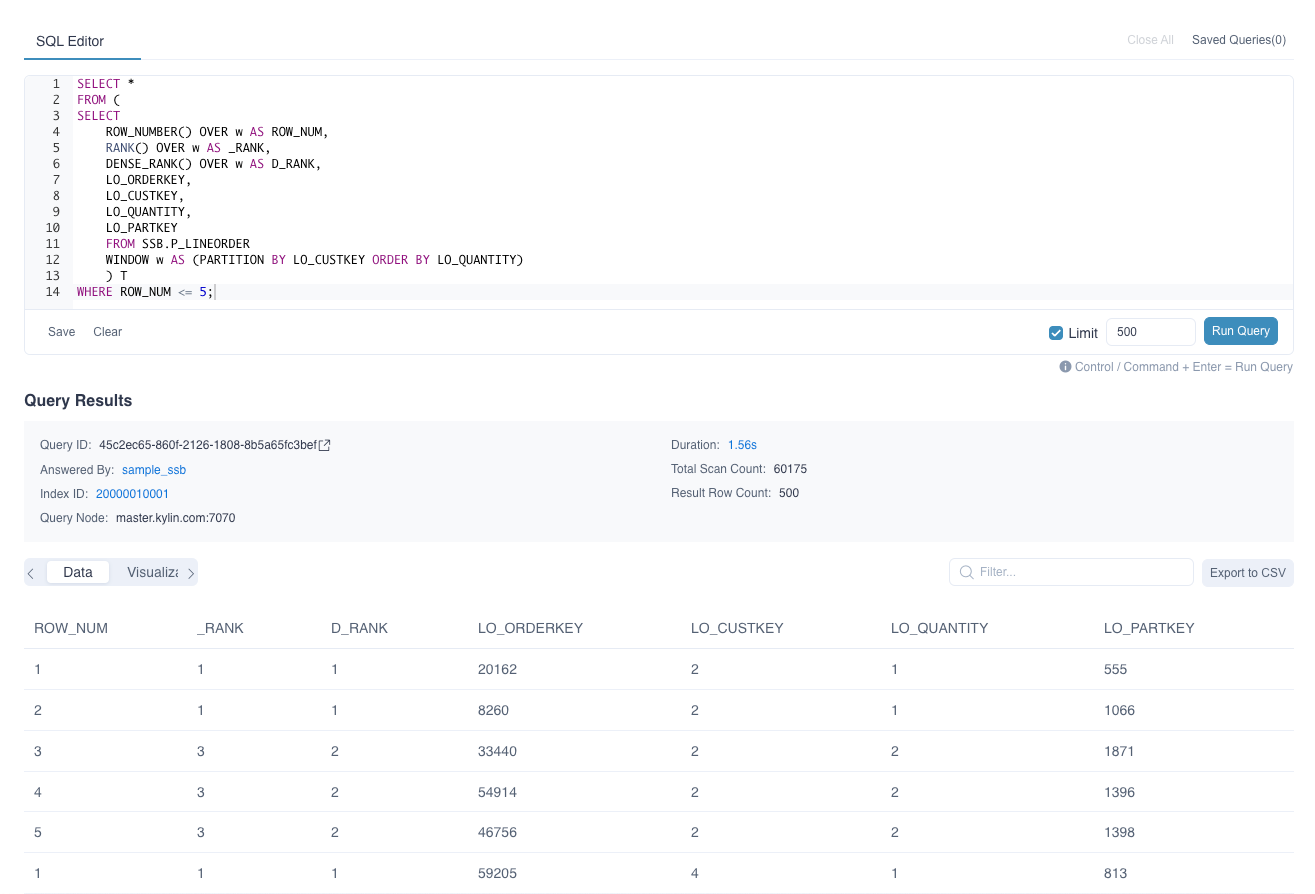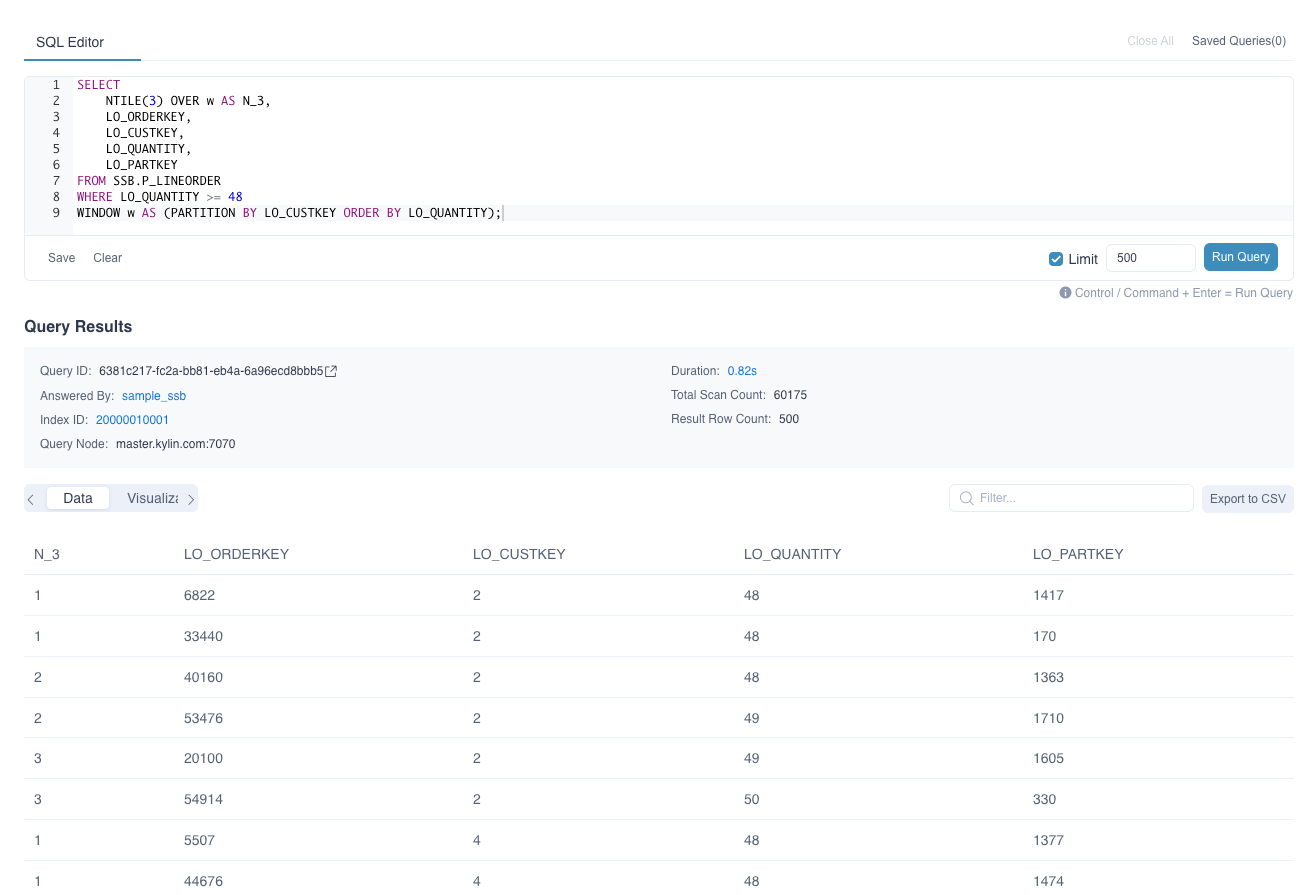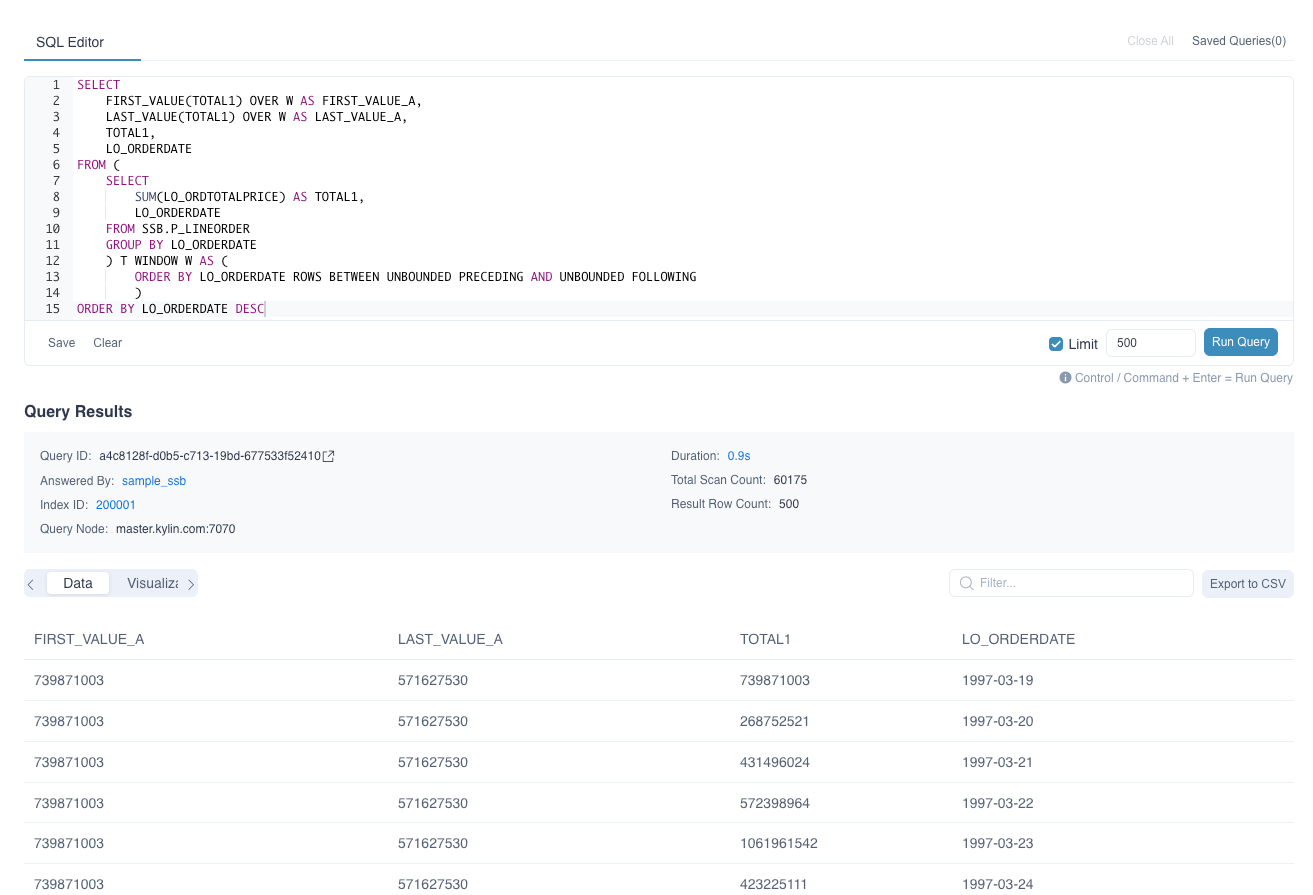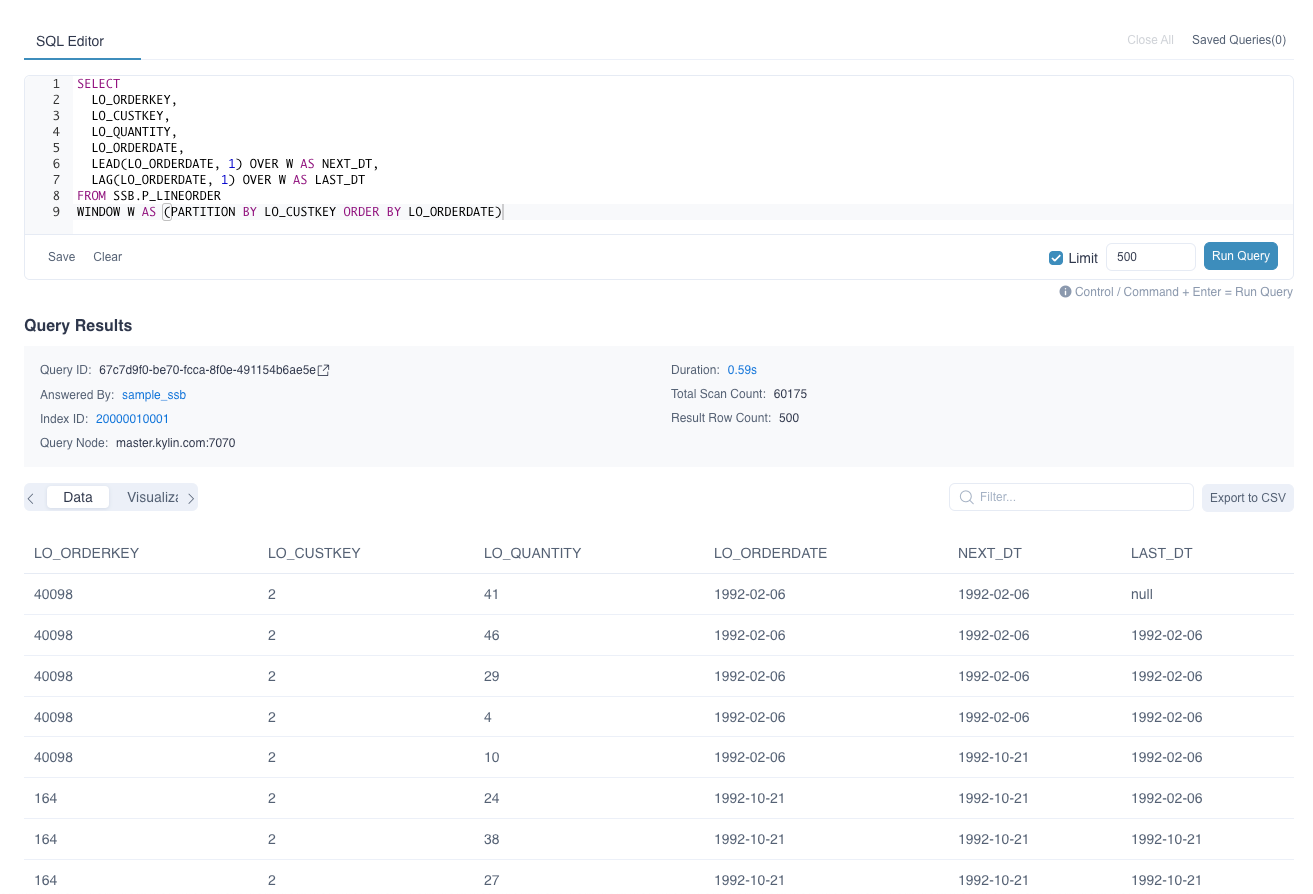Window Functions
Window functions are a powerful tool that can simplify complex queries and improve performance. They allow you to perform calculations on a set of rows that are related to the current row, such as finding the sum or average of values in a specific range.
Window functions are not supported for defining or recommending computed columns.
Syntax Structure
The basic syntax for using a window function is as follows:
function(value) OVER window
Window Clause
A window consists of three clauses:
partition by: a group clause that defines the calculation range of the window function.order by: a sort clause that specifies the sorting method within the group after partition.rows/range: a window clause that determines a sliding data window within the group.-- rows is a physical window that selects a fixed number of rows before and after
-- the current row number, based on the `order by` clause. The result is independent
-- of the current row's value, but rather its sorted row number.
sum(columnA) rows between 1 preceding and 2 following;
-- Explain: If the current row's `columnA` has a sorted row number of 3, this clause
-- selects rows with sequence numbers between 2 and 5.
-- range is a logical window that selects a fixed number of rows before and after
-- the current row's value. The result is independent of the sorted row number, but
-- rather the row's value.
sum(columnA) range between 1 preceding and 2 following;
-- Explain: If the current row's `columnA` value is 3, this clause selects rows with
-- values between 2 and 5.
If an order by clause is specified without a window clause, the default window clause is equivalent to range between unbounded preceding and current row.
Function Part
- ROW_NUMBER(): Returning the position of the current row in its partition, the sequence numbers are not repeated.
- RANK(): Returning the position of the current row in its partition, possibly with sequence gaps.
- DENSE_RANK(): Returning the position of the current row in its partition, with no sequence gaps.
- NTILE(value): Returning an integer ranging from 1 to value, dividing the partition as equally possible.
- FIRST_VALUE(value): Returning value evaluated at the row that is the first row of the window frame.
- LAST_VALUE(value): Returning value evaluated at the row that is the last row of the window frame.
- LAG(value, offset, default): Returning the forward offset of the current row in the partition. value represents the field as the column value, offset represents the number that needs to be looked up in the offset row forwards based on the current value, default represents the value returned by default when there is no eligible value, and null is returned by default if not filled.
- LEAD(value, offset, default): Returning the offset row backwards from the current row in the partition. value represents the column as the current value, offset represents the number that needs to be searched for the offset row backwards based on the current value, and default represents the value returned by default when there is no eligible value, and null is returned by default if not filled.
Examples
The following examples demonstrate the usage of window functions with the P_LINEORDER table from the sample dataset. This dataset includes field descriptions for reference.
Example 1: RANK Functions
Using RANK (), DENSE_RANK (), and ROW_NUMBER () in a single query to retrieve the first five orders with the least number of items purchased by each buyer. The query is as follows:
SELECT *
FROM (
SELECT
ROW_NUMBER() OVER w AS ROW_NUM,
RANK() OVER w AS _RANK,
DENSE_RANK() OVER w AS D_RANK,
LO_ORDERKEY,
LO_CUSTKEY,
LO_QUANTITY,
LO_PARTKEY
FROM SSB.P_LINEORDER
WINDOW w AS (PARTITION BY LO_CUSTKEY ORDER BY LO_QUANTITY)
) T
WHERE ROW_NUM <= 5;

For a buyer with id '1', the following ranking scenarios are observed:
-
row_number() Function
- Orders with LO_QUANTITY = 1 are ranked sequentially: 1, 2, 3, 4
- The order with LO_QUANTITY = 2 is ranked as 5
-
rank() Function
- Orders with LO_QUANTITY = 1 are ranked equally: 1, 1, 1, 1
- The order with LO_QUANTITY = 2 is ranked as 5, resulting in sequence gaps
-
dense_rank() Function
- Orders with LO_QUANTITY = 1 are ranked equally: 1, 1, 1, 1
- The order with LO_QUANTITY = 2 is ranked as 2, with no sequence gaps
Example 2: NTILE
The orders of each buyer are divided into 3 groups according to the number of purchased products. In order to display the search results completely, the orders with the number of products greater than or equal to 48 are selected for grouping.
SELECT
NTILE(3) OVER w AS N_3,
LO_ORDERKEY,
LO_CUSTKEY,
LO_QUANTITY,
LO_PARTKEY
FROM SSB.P_LINEORDER
WHERE LO_QUANTITY >= 48
WINDOW w AS (PARTITION BY LO_CUSTKEY ORDER BY LO_QUANTITY);

Example 3: FIRST_VALUE and LAST_VALUE
Query the first order and the last order with the highest total price sorted by date.
SELECT
FIRST_VALUE(TOTAL1) OVER W AS FIRST_VALUE_A,
LAST_VALUE(TOTAL1) OVER W AS LAST_VALUE_A,
TOTAL1,
LO_ORDERDATE
FROM (
SELECT
SUM(LO_ORDTOTALPRICE) AS TOTAL1,
LO_ORDERDATE
FROM SSB.P_LINEORDER
GROUP BY LO_ORDERDATE
) T WINDOW W AS (
ORDER BY LO_ORDERDATE ROWS BETWEEN UNBOUNDED PRECEDING AND UNBOUNDED FOLLOWING
)
ORDER BY LO_ORDERDATE DESC

Example 4: LEAD and LAG
Query the time of last order and next order based on current order.
SELECT
LO_ORDERKEY,
LO_CUSTKEY,
LO_QUANTITY,
LO_ORDERDATE,
LEAD(LO_ORDERDATE, 1) OVER W AS NEXT_DT,
LAG(LO_ORDERDATE, 1) OVER W AS LAST_DT
FROM SSB.P_LINEORDER
WINDOW W AS (PARTITION BY LO_CUSTKEY ORDER BY LO_ORDERDATE)
